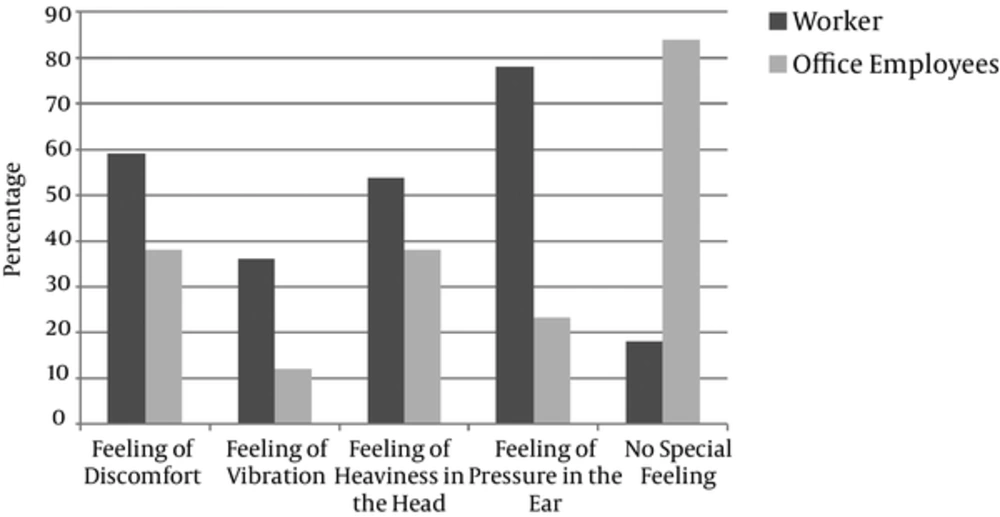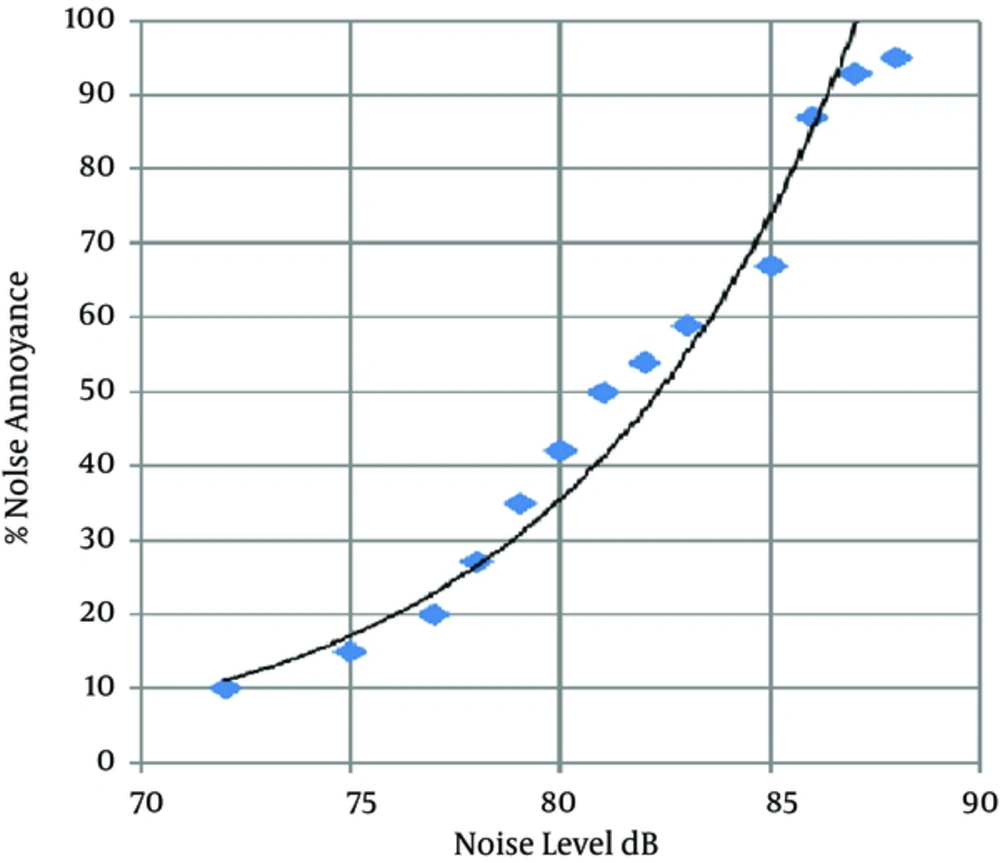1. Introduction
People in different work environments due to their job duties are faced with multiple risk factors. Noise exposure is one of the most hazardous factors in work enviroments. The world health organization has mentioned noise pollution as the third most dangerous factor in everyday life (1). Workers’ health, comfort and performance are negatively affected by noise. Several studies were conducted regarding the well-known harmful effects of noise (2-5). High levels of industrial noise have remained an unsolved problem in all regions of the world, especially in developing countries. In the USA, for example it is estimated that more than 30 million workers (in Iran more two million) are exposed to hazardous levels of noise (6). Anger et al. stated that noise has many adverse effects on performance, health and productivity in any work field (7). Unwanted noise effects human health including temporary and permanent hearing loss, cardiovascular disease, adverse effects on sleep quality, increased blood pressure and etc. (4, 8). Among these effects, damage to the auditory system is the most important consequence of chronic noise exposure in industries (9). The results of some studies on noise pollution in steel factories showed that noise levels in workstations were between 75 and 105 dB (10-12). Noise annoyance is considered as one of the negative effects of noise exposure and can be measured as a subjective response, and it is considered as one of the most important negative effects of noise. According to the world health organization, “Noise annoyance may be defined as a feeling of displeasure evoked by a noise” (13). Recently, a new category of studies have considered noise exposure and its induced annoyance both in experimental and industrial contexts (14-16). Berglund et al. stated that annoyance is one of the most studied effects of ambient noise exposure (17). Noise annoyance can be regarded as an indicator of negative reactions to noise (18), also it may act as a mediator in the causal chain of noise and health (19). The common effect of exposure to industrial noise on the annoyance of workers has been a topic of debate among researchers (3, 20, 21).
2. Objectives
This study was performed in a steel factory to assess noise exposure and noise annoyance in both office employees and production line workers in Ahvaz during year 2015.
3. Material and Method
3.1. Study Population
This study was designed and conducted in a steel factory in Ahvaz city, during year 2015.
For this purpose, 70 male participants were enrolled in the study.
Thiry-three office employees with mean age and mean work experience of 28 ± 2 and 3 ± 1 years, participated in the study. Also, 37 production line workers with mean age and mean work experience of 32 ± 3 and 10 ± 4 years, took part in the study. The purpose of the study was fully described to the participants and they were free to leave the experiments whenever they choose.
3.2. Field Measurement
The (A) weighted sound pressure level was measured by a sound level meter, model Kimo 200 (France). Regular grid of 10 × 10 meters was selected for field measurements in the factory. For field measurement in offices, 1 × 1 m grids were used, and the sound level meter was positioned at a height of 1.2 m above the ground. The microphone was placed far from any reflecting surface with more than 1 m.
3.3. Annoyance Measurement Questionnaire
The annoyance questionnaire included general socio-demographic data, including age, marital status, years of education, and years of work experience. Annoyance by industrial noise during the last 12 months was estimated using verbal annoyance scale, graded as: 0 - ‘not at all’, 1 - ‘slightly’, 2 - ‘moderately’, 3 - ‘very’ and 4 - ‘extremely’. This five-point scale complies with the recommendations of the international commission on the biological effects of noise (Fields et al., 1998). Participants, who claimed being ‘very’ and ‘extremely’ annoyed by industrial noise were classified as ‘highly annoyed’. The other three categories were defined as ‘low level of noise annoyance’.
Annoyance was judged, using the ISO standardized scale (ISO/TS 15666:2003) (22) and the following instruction was given: ‘What number from zero to ten best shows how much you are bothered, disturbed, or annoyed by the noise you have just heard? If you are not at all annoyed choose zero, if you are extremely annoyed choose ten, if you are somewhere in between choose a number between zero and ten’.
As the last part of the questionnaire, the participants were asked to mention the most common symptom they had experienced after exposure to noise from a list including: feeling of discomfort, feeling of vibration, feeling of heaviness in the head, feeling of pressure in the ear and no special feeling.
3.4. Statistical Analysis
Descriptive statistics was presented as mean ± standard deviation (SD) for numeric variables. Differences between the two groups in parametric data were tested using Student's t-test. A probability level of less than 0.05 was accepted as significant. To analyze the data, SPSS 22.0 for Windows software was used (IBM - SPSS Inc., 1989 - 2013).
4. Results
Table 1 represents noise parameters at the investigated work stations. According to the presented results, two of the measured areas in the production line (work station No. 4 and 6) have noise levels below the standard noise exposure level, and other work stations were above the recommended level by ACGIH. As it was expected, in the office area all the measured noise levels were below the industrial noise threshold level but it should be stated that for office work another threshold limit should be used, which is the comfort level threshold.
| Noise Measurement Area | Number of Exposed | Sound Pressure Level dB-A | LAeq-8hr dB-A | |
|---|---|---|---|---|
| Employees | Min | Max | ||
| Office 1 | 4 | 62 | 76 | 73 |
| Office 2 | 4 | 59 | 75 | 72 |
| Office 3 | 3 | 61 | 78 | 75 |
| Office 4 | 6 | 70 | 79 | 78 |
| Office 5 | 16 | 68 | 82 | 79 |
| Work station No. 1 | 6 | 84 | 90 | 89 |
| Work station No. 2 | 5 | 81 | 89 | 88 |
| Work station No. 3 | 5 | 82 | 88 | 86 |
| Work station No. 4 | 6 | 80 | 87 | 85 |
| Work station No. 5 | 5 | 84 | 89 | 87 |
| Work station No. 6 | 5 | 79 | 86 | 85 |
| Work station No. 7 | 5 | 83 | 89 | 86 |
Noise Measurement Results for the Study Area
Table 2 shows noise annoyance levels in two categories of low and high annoyance in different study areas. In summery, 8 out of 33 (24.24%) employees in the office area had high noise annoyance. The result of paired sample t-test between two groups showed a significant relationship between noise annoyance and work groups (P < 0.005).
| Study Area | Number of Exposed | Noise Annoyance Level | Paired t-Test | ||||
|---|---|---|---|---|---|---|---|
| Employees | Low (%) | High (%) | |||||
| Not at All | Slightly | Moderately | Very | Extremely | |||
| Office 1 | 4 | 2 (100) | 1 (25) | 1 (25) | 0 | 0 | 0.005 |
| Office 2 | 4 | 1 (25) | 1 (25) | 1 (25) | 1 (25) | 0 | |
| Office 3 | 3 | 3 (100) | 0 | 0 | 0 | 0 | |
| Office 4 | 6 | 1 (16.7) | 1 (16.7) | 2 (33.5) | 1 (16.5) | 1 (16.5) | |
| Office 5 | 16 | 3 (18.8) | 5 (31.4) | 3 (18.8) | 2 (12.4) | 5 (24.8) | |
| Work station No.1 | 6 | 0 | 3 (50) | 0 | 1 (16.7) | 3 (33.3) | |
| Work station No.2 | 5 | 0 | 1 (20) | 1 (20) | 0 | 3 (60) | |
| Work station No.3 | 5 | 0 | 0 | 3 (60) | 0 | 2 (40) | |
| Work station No.4 | 6 | 0 | 2 (33.5) | 2 (33.5) | 1 (16.5) | 1 (16.5) | |
| Work station No.5 | 5 | 0 | 1 (20) | 1 (20) | 1 (20) | 2 (40) | |
| Work station No.6 | 5 | 0 | 1 (20) | 1 (20) | 0 | 3 (60) | |
| Work station No.7 | 5 | 0 | 0 | 1 (20) | 2 (40) | 2 (40) | |
Levels of Noise Annoyance in Exposed Employees
Also, in the production line area, 20 out of 37 (54%) of workers stated being highly annoyed by industrial noise.
Figure 1 shows the percentage of symptoms that office employees and blue-collar workers felt after noise exposure.
Figure 2 represents a positive relationship between industrial noise levels and percentage of respondents, who felt highly annoyed. The percentage of respondents, who were highly annoyed increased with increasing noise levels.
5. Discussion
According to the study results, noise levels in offices and workstations revealed that noise pressure levels ranged from 61 to 82 dB and 79 to 90 dB (A), respectively. This finding is similar to the study by Ali 2011, Zeng et al. 2007 and Atmaca et al. 2005 (3, 10, 23). Ali (2011) showed that workers in jobs with high sound pressure levels, had more complaints of noise annoyance.
Luszczynsk et al. (2003) while studying effect of low frequency noise with broadband on workers’ feeling of annoyance in a cement factory observed a liner regression relationship between noise exposure and noise annoyance in workers (24). The present study is supported by these findings.
As stated earlier, we found that 66.7% of office employees were exposed to noise levels above recommended threshold for precision work. Similarly, 70% of blue-collar workers were exposed to noise levels above occupational permissible limit. Also, 40% of all participants stated being highly annoyed by noise. This result is supported by Bedi 2006, Ahmed 2012 and Singh et al. 2009 (25-27).
For all production line workers the measured noise level was above action level (82 dB-A). Thus there is an urgent need for a hearing protection program. According to the results, office employees stated a series of complaints from feeling of vibration to no special feeling. On the other hand, blue-collar workers stated a series of complaints from no special feeling to feeling pressure on the ears. Perera et al. stated that the major complain reported by workers was discomfort (28). There was a strong significant relationship between noise levels and percentage of noise induced annoyance (P value < 0.05). By increasing noise level, the percentage of highly annoyed participants increased.
5.1. Conclusion
The findings of this investigation have clearly revealed that employees in both parts of the steel factory are annoyed by noise and the blue-collar workers are at risk of developing noise induced hearing loss. There was a positive relationship between noise annoyance and noise levels. There is a need to have a hearing conservation program in both sections of the steel factory, including; education, noise assessment, usage of hearing protection devices, and audiometry for employees working in the investigated steel plant.

